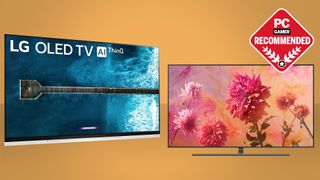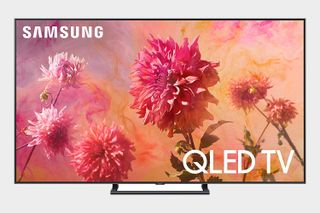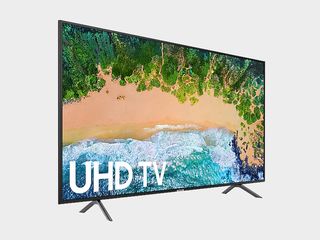The best 4K TV for gaming PCs

For PC owners, there's a choice: do you want the best 4K TV for gaming to go all-out on a massive 4K and HDR display, or do you want the luxury of 240Hz frame rates and slightly lower resolution play on a smaller gaming monitor? Frankly, unless your rig is capable of outputting 4K at a solid 60 fps or 120 fps, that decision seems easier: there's little point specifically aiming for a 4K TV as your go-to display unless you can get the most from it. If you're all set with a 2080 Super inside your machine (or a Ti or two), then suddenly a 4K TV is a viable option. You'll get a larger panel for your money than almost any monitor, the HDR will be brighter, and most high-end TVs do offer 120Hz along with other game-focused features like Freesync and even G-Sync in some cases.
Our top pick for the best 4K TV for gaming is the LG OLED E9 series, which is the 2019 model. While already a superb series of panels, and ones we'd heartily recommend for movies and TV too, LG has also announced that they'll be getting G-sync support in the next few weeks too. That's a huge deal, and clearly a play for the PC market. That does currently make the LG sets the clear winner in the PC gaming sphere. However, if you're looking for an all-purpose TV that works well for all kinds of viewing, we'd also strongly recommend the Samsung QLED panels. We're currently testing the 2019 top-model, the Q90R, and it's stunning. For now, though, if you can get hold of it then the 2018 Q9F offers near-parallel performance for about half the price. It's a hell of a TV.




LG OLED65E9PUA - 65" 4K TV
Specifications
Reasons to buy
Reasons to avoid
With each year, LG’s OLED panels get stronger and stronger for gaming. The E9 is 2019’s model and it packs in many of the same features from last year’s E8 (our favorite gaming TV for so long), albeit with some key changes. The panel is still among the thinnest of all 4K TVs, and it brings unrivalled black levels thanks to the OLED tech allowing individual LEDs to be completely switched on and off. That’s how you get such deep blacks and the clarity and sharpness of image with them. It makes the E9 panels perfect for darker games like Metro: Exodus and Resident Evil 2: Remake.
Even better news is that G-sync is (or will be soon) enabled on all E9-series TVs, when you have Game Mode active, so you no longer have to suffer through skipped frames and torn pictures when playing at higher frame-rates. HDR isn’t toned down in LG’s Game Mode either, so you still get that vibrancy while benefiting from better response and refresh rates. Unfortunately, you can still only play 4K at 60Hz on the E9-series (as it was with the E8), but the response rate has been boosted over the previous year, and now sits at a handsome 6ms for 1440p and 13ms for 4K.
The LG E9 is also capable of Dolby Atmos 4.2 sound, which is perfect for 4K movies if you run them through PC, and while its HDR brightness isn’t quite on a par with the QLED panels from Samsung (which favor color vibrancy over deep blacks), the Dolby Vision here is superb. As with most OLED panels, the thinness of the screen means sound output itself is never going to be as rich as a separate speaker system (speaker size is sacrificed for aesthetics), but the E9 still manages surprisingly good audio too that surpasses the E8. We’d recommend a premium gaming headset to really set the experience off, or a top-class audio system, but it’s by no means a deal-breaker.
Picking up older models like the E8 and C8 will net you a picture that’s almost on a par with the E9 for less money but, beware, they’ll be missing that G-sync tech and won’t have the same response rates.

Samsung Q9F 65"
Specifications
Reasons to buy
Reasons to avoid
While OLED is best for the inkiest of blacks, Samsung's QLED tech leads the way when it comes to vibrant colors and vivid contrasts. The Q9F is 2018's best 4K TV, and while it has now been replaced as the flagship model by the Q90R, it remains a showstopping panel. What's more, you can now pick it up for half the price, making this elite TV actually affordable, and it has almost all the features present in the newer (vastly more expensive) Q90R.
PC Gamer Newsletter
Sign up to get the best content of the week, and great gaming deals, as picked by the editors.
The headline feature is its HDR 2000 tech, which is the most vivid HDR of any commercially available TV. It's all very well boasting about it, but you can actually see a significant boost in vibrancy from every other TV set, with a noticeably bigger range of colors. 4K content looks stunning, but the TV also does a fantastic job of upscaling regular HD pictures and even SD content, making them more colorful and with smoother motion and edges. It's a fantastic all-rounder, thanks to direct full array LED picture display, and the anti-reflection screen is the icing on the cake.
What's more, the sound is very good too, which is unusual for TVs that place such an emphasis on soundbars and headsets. Having used external SONOS speakers for years, with other TVs, we finally found that the Q9F delivered superior audio. It's all finished off with a single-wire set-up, meaning you get no clutter behind the TV, and an ambient mode that lets you display art on the panel (or let it blend into your wall) when you're not using it. The only downside? The viewing angle is limited, so you get a loss in vibrancy if you're watching beyond 45 degrees which, with such a large TV that's designed to be the centerpiece of your room, is such a minor complaint. This is one of the best value TVs right now, and also one of the best you'll ever own.

Sony X900F 49"
Specifications
Reasons to buy
Reasons to avoid
Although Sony’s X900F LCD TV series came out in 2018, they’re very much still available. And handily, their relative age means they’re still available at massively reduced prices. In fact, if you snap one up now, you’re truly getting an upper mid-range big-brand TV for the price of an entry level one.
The key to their success is that despite their affordability, they use direct LED lighting with local dimming—like the Samsung Q8FN. There aren’t as many ‘dimming zones’ as you get with the Q8FN, but having this sort of backlight configuration at all is remarkable for such an affordable TV.
The result is a far better contrast performance than you can get from literally any other TV in its price class. And as we’ve highlighted throughout this article, a good contrast performance by a display is fundamentally important to an exciting HDR gaming picture.
Also great news for gamers is the X900F series’ Triluminos colour system. This uses proprietary Sony processing to produce a wider and more subtly nuanced colour performance than any other TV in its price class. This means 4K HDR game imagery looks more vibrant, rich and detailed.
Inevitably for its money, the X900F does not support the high frame rates of the LG OLEDE8 series, or the automatic game mode switching and variable refresh rate features of the Samsung Q8FNs. Also, because it uses far fewer dimming zones than the Samsung Q8FNs, you can sometimes see gentle halos of light around bright objects if they appear against dark backgrounds. This becomes exaggerated if you have to watch from an angle. The X900F series can only hit around half the brightness achieved by the Samsung LCD model, too.
The set does partner its still great pictures, though, with a respectably low 30ms of input lag if you use its game preset. And the bottom line is that no TVs as affordable as the X900Fs are going to be perfect. All that really matters here is that the X900F is comfortably the all-round best TV for gaming in its price range.

TCL 55R617 55" Roku TV
Specifications
Reasons to buy
Reasons to avoid
If you're looking to buy a 55" TV on a budget, look no further than the TCL 6-series. This is 2018's model, but that means you can often find it on sale but, quite frankly, it's a bargain at full price. While the earlier TCL models suffered from poor build quality, and several screen flaws, the 6-series solved these issues to deliver an ace Roku-powered TV. What's more, it's great for gaming too. While it doesn't have the low, low response rate of other panels, it manages between 6ms-12ms, which is above average for TVs of this size and price. What's more, it has full-array local dimming, which means the contrast ratios are good (the blacks, especially, are nice and deep).
Where the TCL suffers is in the color range, which is merely average for 4K TVs of this budget. While it has decent HDR, that can't quite mask the lower vibrancy of images, although (to be honest) you're unlikely to notice much of a difference unless you're playing the most colorful of games. At 55", it's less noticeable too, although if you're looking to go 65" you need to work out if you're ok getting a TV that does blacks and dark tones better than colors and light tones. For the price, however, it's very tough to fault the TCL 617. It even comes with voice control if you're into that sort of thing.
You can even drop down to 43" if you're looking for a 4K TV as part of a PC set-up / second room gaming rig. The contrast remains as impressive, and it's obviously a little cheaper too.

Samsung NU7100 50"
Specifications
Reasons to buy
Reasons to avoid
If money really is an issue, but you still want a large TV that can handle your PC games, the NU7100 series from Samsung is your savior. You can pick it up for relatively little, and you can save even more money on smaller versions, but the performance you get is well above average. With game mode enabled, this TV manages a 120Hz refresh rate with a 15ms response time, which is very much the average for TVs that are double the price of this one. So, you're getting excellent performance for what you pay.
The HDR and 4K pictures are good too, although not as mind-blowing as you'd get from an OLED or QLED. Then again, you're paying roughly a quarter of the price. You get all Samsung's smart features built into this TV too, such as the mobile app, Bluetooth sharing, a universal TV guide, and all that kind of stuff. What's more, the NU7100 also has Steamlink, which is super handy for PC gaming, and the panel itself is fast enough to keep up with the majority of games.
While this TV won't wow guests, or have the best viewing angles for parties or whole-household use, it's a great one to replace a gaming monitor, or to host a smaller PC built into a living room set-up. You wouldn't pair it with a $2500+ gaming PC, but it's amazing value for anyone looking to have it as part of a second-TV set-up or a less powerful PC display.
Most Popular

